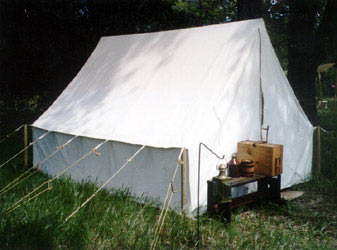When I started camping in the 1960's, most tents had some varation of the traditional A-frame design.
Although traditionally made of canvas material, they could be erected with as few as two poles. If you added a ridge pole, the tent was much improved for little additional weight. A good scout prided himself in being able to erect a tent within two minutes an closer to one minute was not an unreasonable goal.
Since then, tents have evolved into all kinds of add shapes mostly based on bent-arch flexible pole concepts, thus, many/most tent designs today are based on rounded shapes or clusters of rounded shapes.
Although tents started out with an eye to economy of space and weight, we have seen an abandonment of those conservative concepts toward bigger, gangly, more complicated designs. many tents today look like a dinasaur egg nest with rounded pods bursting out of even bigger pods. They are taking longer to set up, more careful planning for the footprint, and offering less in terms of weather protection.
I recently camped an older A-frame tent and was reminded of the ease and speed of set-up, the efficiency of useable space, and the weather protection provided. For example, while dome shaped tents might offer standing room in the center of the tent, a tall A-frame tent offers standing room for the whole length of the tents.
With the A-Frame tent, there was no mystery about what poles went in which direction. There were no sleeves to thread poles through.
I imagined the tent being made of modern materials - ripstop nylon and woven synthetics. Perhaps carbon fiber poles or even lower cost aluminum. While these sythetic A-Frame tents were available for a very short time in the late 1970's and early 1980's the rush toward the newer "dome tents" was fast and furious and the A-frame was quickly left a relic of the past.
I think it is time to revisit the A-frame tent such as the A-frame wall tent design and others. Make them out of Modern, lightweight durable synthetic materials and make sure to add a rainfly. For further simplicity, go without the floor. I am sure they exist today and I am also sure that if people were to try them (again), they would be impressed with their simplicity, functionality, and economy of weight and space

Although traditionally made of canvas material, they could be erected with as few as two poles. If you added a ridge pole, the tent was much improved for little additional weight. A good scout prided himself in being able to erect a tent within two minutes an closer to one minute was not an unreasonable goal.
Since then, tents have evolved into all kinds of add shapes mostly based on bent-arch flexible pole concepts, thus, many/most tent designs today are based on rounded shapes or clusters of rounded shapes.
Although tents started out with an eye to economy of space and weight, we have seen an abandonment of those conservative concepts toward bigger, gangly, more complicated designs. many tents today look like a dinasaur egg nest with rounded pods bursting out of even bigger pods. They are taking longer to set up, more careful planning for the footprint, and offering less in terms of weather protection.
I recently camped an older A-frame tent and was reminded of the ease and speed of set-up, the efficiency of useable space, and the weather protection provided. For example, while dome shaped tents might offer standing room in the center of the tent, a tall A-frame tent offers standing room for the whole length of the tents.
With the A-Frame tent, there was no mystery about what poles went in which direction. There were no sleeves to thread poles through.
I imagined the tent being made of modern materials - ripstop nylon and woven synthetics. Perhaps carbon fiber poles or even lower cost aluminum. While these sythetic A-Frame tents were available for a very short time in the late 1970's and early 1980's the rush toward the newer "dome tents" was fast and furious and the A-frame was quickly left a relic of the past.
I think it is time to revisit the A-frame tent such as the A-frame wall tent design and others. Make them out of Modern, lightweight durable synthetic materials and make sure to add a rainfly. For further simplicity, go without the floor. I am sure they exist today and I am also sure that if people were to try them (again), they would be impressed with their simplicity, functionality, and economy of weight and space




Comment